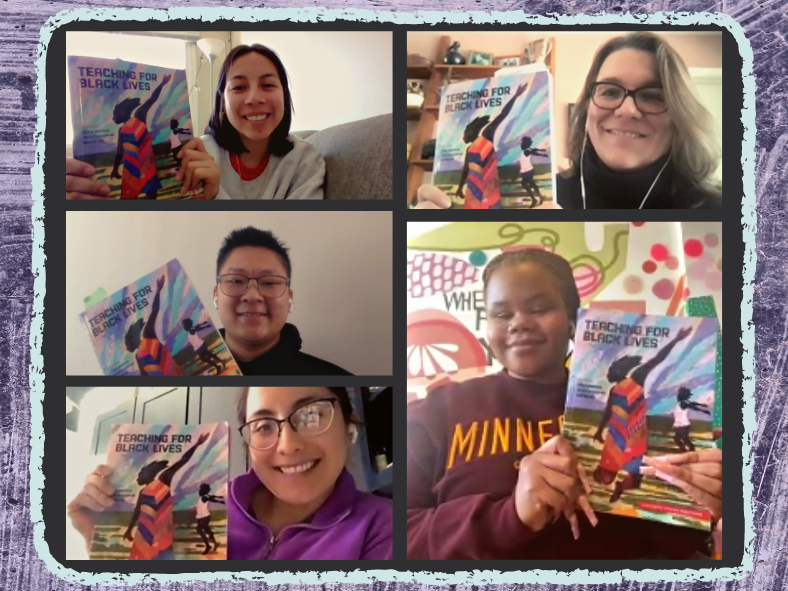
University of Minnesota Twin Cities T4BL Study Group
The Minneapolis Teaching for Black Lives study group is comprised of 18 aspiring and practicing social studies teachers of color from the Teaching Program at the University of Minnesota Twin Cities. Jehanne Beaton, instructor in the social studies licensure program, has been coordinating the group since the 2021-22 school year. Ten original study group members continue to participate for the second year. They meet monthly via Zoom or in-person.
During a recent meeting, they focused on Section 5 of Teaching for Black Lives, “Teaching Blackness, Loving Blackness and Exploring Identity.” After taking five minutes to skim through the section to recall what stood out to them, Dyani Acosta, pre-service 6th and 8th-grade teacher, mentioned the article, “Raised by Women,” by Linda Christensen:
I really like poetry because it explores a way of talking about yourself without explicitly talking about yourself. I think it’s a good way to convince kids to share more about themselves. I liked how it gave examples of all the different kinds of realities students share about themselves.
Sofía Cerkvenik, 7th-grade U.S. studies teacher in her third year of teaching, read “Dear White Teacher.” She said, “I like how this book gives you a tangible list of things to do sometimes. Here is an example of a conversation with a parent, and how we can grow from there. I really appreciate that.”
Shaunassey Johnson, a 9th-grade ethnic studies teacher, read “#MeToo and The Color Purple.” She appreciated the recommendation to use The Color Purple as a vehicle to “allow students to be able to investigate or talk about these issues of abuse and sexual assault.”
She said:
There’s something really tangible about stories like The Color Purple. . .[characters] learning about themselves, their sexuality, learning that the shame from what occurred isn’t on them — I think that’s why I really like this section. I would like to explore more books that center the identities of marginalized people, specifically poor Black women.
Quynh Vu, 12th-grade government teacher, read the same piece and connected it to a recent article from the CDC (Center for Disease Control and Prevention). She read:
Recently published statistics that depression, suicide, and so on are up incredibly high, specifically for teenage girls and that’s because of sexual assaults and sexual harassment. It just speaks to the culture we’re reproducing, where it’s okay to enact violence on someone else’s body. There’s often no conversations of gender in the classroom or gender dynamics of how it shows up. A lot of staff tend to gloss over it and don’t understand the impact it can have.
Dyani said she had noticed alarming behaviors in boys, particularly white boys:
The thing is, we’ve brought some of this up to admin or behavior specialists and counselors. Admin doesn’t do anything about it and it makes me really question: How often do we let boys enact certain types of violence? If this continues to slide and we don’t pay attention to it now, how far is it going to go?
Jehanne shared a discussion that occurred in her methods class. Aspiring social studies teachers discussed the possibility of teaching Harriet Jacobs’ narrative, which involves sexual abuse, in their high school classrooms.
The conversation among the teachers was: Is this appropriate for the classroom? Is it okay to talk about this?
If we don’t include the ways in which sexual violence was part of that system, aren’t we just basically ignoring the experience of so many people who were enslaved at that time?
Shaunassey said the reality of sexual assault is one of the biggest challenges when teaching about enslavement. “No one talks about the trauma, sexual trauma.” She recalled when she was in elementary school. “As a lighter skinned Black girl, I felt certain that there was sexual assault in my family history. That’s what kids are thinking about when you talk about slavery. They’re getting to that point on their own. Why isn’t this more readily talked about in their classrooms?”
Sofia said, “For me, it feels important to find ways, even in the middle school setting, to bring in women and women-identifying perspectives in a way that isn’t traumatizing, to engage in conversations that are nuanced.”

